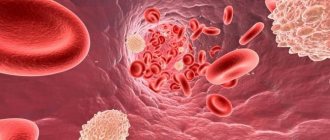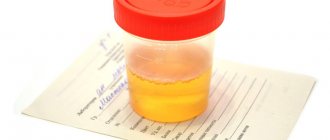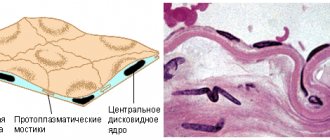Types of urine tests:
A general urine test is the most common and common test. This test is prescribed when the first symptoms of the disease appear and for preventive purposes.
There are also special urine tests for a child, which are prescribed only for diagnostic purposes. For example, a urine test according to Nechiporenko (if cystitis, glomeronephritis, pyelonephritis is suspected), Zimnitsky test to assess the condition of the kidneys, Sulkovich test (a screening test to determine the amount of calcium in the body), Rehberg test (to assess the efficiency of the kidneys), urine test for hormones , urine culture for sensitivity to antibiotics , etc.
How to properly prepare a child for a general blood test, how to collect urine for analysis.
In order for the results of a child’s urine test to be reliable, it is necessary to properly prepare the child for the test. On the eve of the urine test, you should not feed your child vegetables and fruits that can change the color of the urine (beets, carrots). Urine for research is collected in a special sterile plastic container or urine bag (for collecting urine from infants), which can be bought at a pharmacy or taken from a diagnostic laboratory. Before collecting urine, be sure to wash your child. Girls are washed from front to back, then, with a cotton swab dipped in warm water, wash the area between the labia. For boys, when washing, the foreskin is pulled back, exposing the head of the penis.
For a general urine test, it is best to take morning urine. The baby releases the first portion of urine into the toilet, and you must collect the rest of the urine in a container. If you collected evening urine, then you need to store the jar with the material in the refrigerator so that the main indicators do not change.
How to get tested
Before you start taking the test, you should definitely warn your doctor about taking medications, because they may affect the result of the test. For biochemical analysis, daily urine is collected in a special clean container, without adding any preservatives to it.
During the Rehberg test, urine is collected during the day, which should be stored in a cool place. The first collection is noted, and the last one, in turn, should occur exactly 24 hours later. Along with donating 24-hour urine, you also need to take a blood sample.
The results can only be interpreted by a doctor. The content of the various elements will differ depending on the patient's age, gender and condition.
Norms of urine tests in children
The normal urine test results for a child depend on the type of analysis and the age of the child. The color of a child’s urine is normally rich yellow, from straw to amber yellow, the urine should be transparent, the smell should not be pungent, there should be no protein in the urine or traces of protein are detected, there should be no glucose (sugar) in the urine, red blood cells Normally, they are not detected or are single in the preparation, leukocytes are normally up to 5 in boys and 8-10 in girls in a single portion of urine, the epithelium is normally single, mucus is practically not found normally.
Purpose and interpretation of a general urine test
Today, the principle of operation of analyzers that process biological material is based on identifying the general condition of urine and determining the acceptable norm of certain indicators. Most often, along with a clinical urine test, a general blood test is also prescribed (for the most complete and accurate diagnosis of the patient). OAM is carried out both to identify a specific disease and to control an existing disease. This study also allows the specialist to understand how effective the prescribed therapy is.
So how do you navigate through the printout of the results table? To do this, it is necessary to understand the norm of all indicators obtained as a result of laboratory testing. This list includes:
- the presence of protein (PRO) (normally should be absent), glucose (GLU), ketone bodies (KET);
- inorganic substances (phosphates, bicarbonates, chlorides, ammonia, etc.);
- leukocytes (LEU), red blood cells (BLD) and bacteria (NIT);
- identification of acid-base balance (pH);
- color (COLOR) and density (SG) assessment;
- as well as hemoglobin, urobilinogen (URO), bilirubin (BIL) and maximum tolerable epithelial cell count (VTC) levels.
Urine analysis is deciphered in a short time, although it has a wide range of different criteria and indicators. When deciphering a general urinalysis, a specialist should focus not on individual indicators, but on the whole picture as a whole; only in the aggregate of all the results obtained can conclusions be drawn about a particular disease. The content of various substances in the urine can vary significantly with the condition of the kidneys or developing disease, so OAM has a high degree of relevance as a diagnostic method.
What to do if the urine test shows leukocytes or red blood cells?
An increase in leukocytes in a child’s urine or the appearance of red blood cells is a reason to consult a doctor. Since untimely treatment of the causes that caused these deviations from the norm is very dangerous.
The presence of red blood cells in a child’s urine (hematuria) indicates that blood is mixed into the urine. Most causes of hematuria require careful evaluation and treatment. Red blood cells appear in glomerulonephritis, pyelonephritis, kidney tumors, cystitis, urolithiasis, intoxication of the body, injury to the kidneys or bladder, etc.
If there is an increased number of white blood cells in a child's urine, make sure that you wash the child thoroughly. The reasons leading to an increase in the level of leukocytes in the urine are a child’s urinary tract infection, a kidney infection, inflammation of the child’s external genitalia, metabolic disorders, etc.
Twelve questions about deciphering urine test results
Is the appearance of protein in urine always associated with kidney damage?
Normally, albumin, light chains of immunoglobulins, and many enzymes pass through the renal filter. An increase in protein in the urine (proteinuria) is the main syndrome of kidney pathology. But the appearance of protein in the urine is not always associated with renal pathology. There is functional proteinuria - the appearance of protein in the urine after eating a large amount of protein food; orthostatic proteinuria - protein in the urine appears when the body position changes from horizontal to vertical. Sometimes protein appears in the urine in healthy people after intense physical exertion, long walking, a cold shower, with profuse sweating, in pregnant women, and newborns.
Are there acceptable levels of sugar (glucose) in urine?
There should be no glucose in the urine. The appearance of glucose in the urine (glucosuria) is associated with impaired carbohydrate metabolism or damage to the pancreas. Glucose appears in urine when its concentration in the blood exceeds the renal threshold (more than 8.88-9.99 mmol/l) in adults. However, glucosuria can be physiological and associated with the consumption of large amounts of carbohydrates, after emotional arousal, stressful conditions, after extensive surgical interventions and be transient.
Can ketone bodies be normally detected in urine?
Normally, ketone bodies are not detected in a urine test. The reason for their appearance may be a violation of metabolic processes in the body. This result of a urine test occurs in patients with diabetes mellitus, alcohol intoxication, acute pancreatitis, and thyrotoxicosis. But a person can be healthy - ketonuria can be of a nutritional nature when eating fatty and protein foods with a lack of carbohydrates, as well as with specific diets - with a predominance of protein foods in the diet, during fasting.
What does bilirubin in urine indicate?
Normally, bilirubin is not detected in urine. The causes of bilirubinuria are liver disease (obstructive jaundice, hepatitis), cholelithiasis. Also, bilirubin in the urine can appear due to massive destruction of red blood cells - this happens with malaria and some blood diseases.
What if urobilinogen is detected in the urine?
Normally, urine contains a certain amount of urobilinogen (this is a bilirubin derivative formed in the body from bilirubin). Therefore, the test for urobilin bodies in the body of an adult is weakly positive. An increase in the amount of urobilinogen in the urine is characteristic of hemolytic conditions, erythremia, resorption of extensive hematomas, hepatitis, intestinal diseases (often in children with colitis, intestinal obstruction, constipation).
What does hemoglobin in urine indicate?
Hemoglobin is a protein found in red blood cells that is involved in oxygen transport. Obviously, it shouldn't be in the urine. When red blood cells are destroyed, a large amount of hemoglobin can be released into the bloodstream, which the liver and spleen do not have time to break down. In this case, free hemoglobin is partially excreted by the kidneys in the urine. Hemoglobin in the urine can be a consequence of blood transfusion, extensive damage to soft tissues, burns, hemolytic disease, malaria, extensive myocardial infarction, poisoning with mushrooms, phenol, sulfonamide drugs (with hemoglobinuria, urine is pink, red, dark brown or black).
Can leukocytes be normally present in urine?
Yes, but in small quantities. In children and women, the norm is considered to be up to 5 leukocytes in the field of view, in men - just a few in the preparation. An increase in the level of leukocytes indicates a pathology of the urinary system. This symptom can occur with various diseases of the kidneys, ureters, bladder or urethra; in men, an increase in white blood cells can occur due to prostatitis. Also, the presence of leukocytes in the urine may be associated with vulvovaginitis. And also with a banal lack of hygiene when collecting analysis.
Does the presence of red blood cells in urine also indicate pathology?
Not always. Normally, red blood cells may be found in urine, but in very small quantities (allowed in women and children). The detection of a large number of red blood cells may indicate a serious pathology of the kidneys or urinary tract - nephrotic syndrome, kidney infarction, urolithiasis.
Can epithelial cells be found in urinary sediment?
Yes, and these are cells of various types - renal epithelium, bladder epithelium, etc. The presence of renal epithelium indicates undoubted kidney damage - nephrosis or acute nephritis. Transitional epithelial cells of the ureters and bladder indicate cystitis or inflammation of the ureters. In women, squamous epithelial cells may be present in urine. This is not dangerous: such cells come from the genital tract and do not indicate a disease.
What does the presence of cylindrical bodies in urine mean?
Cylindrical bodies (cylinders) form in the kidney tissue (in the renal tubules) and indicate serious pathology. They can be different in composition and include red blood cells, desquamated cells of the renal tubules, and protein. Normally, only hyaline casts are permissible in urine, and only single ones. They can appear in the urine during sudden dehydration of the body, after heavy physical exertion, when working in hot shops, or when consuming large amounts of protein foods. Detection of other types of cylinders is a sign of renal pathology.
What does the presence of fungi in urine indicate?
There should be no fungi in the urine. If they appear, check for infectious fungal infections of the urinary tract (cystitis, urethritis, prostatitis); fungal infections of the external genitalia (vulvovaginitis). The cause of the appearance of fungi in the urine may be long-term use of antibiotics, as well as an immunodeficiency state.
What does the expression “diastasis in urine” mean?
Diastase (or amylase) in the urine is an indicator that makes it possible to diagnose pancreatitis. Amylase is an enzyme that is involved in the breakdown of long chains of carbohydrates during digestion. The highest concentration of this enzyme is in the juice of the pancreas, which synthesizes it. When the pancreas becomes inflamed, some of the amylase enters the blood, reaches the kidneys and is excreted from the body. That is, if there is increased amylase in the urine, this indicator will be increased in the blood. A urine test allows you to monitor amylase concentrations without drawing blood. A significant increase in the diastase index - over 8000 units - indicates acute pancreatitis or an exacerbation of chronic
Biryuk N.V., laboratory diagnostics doctor







